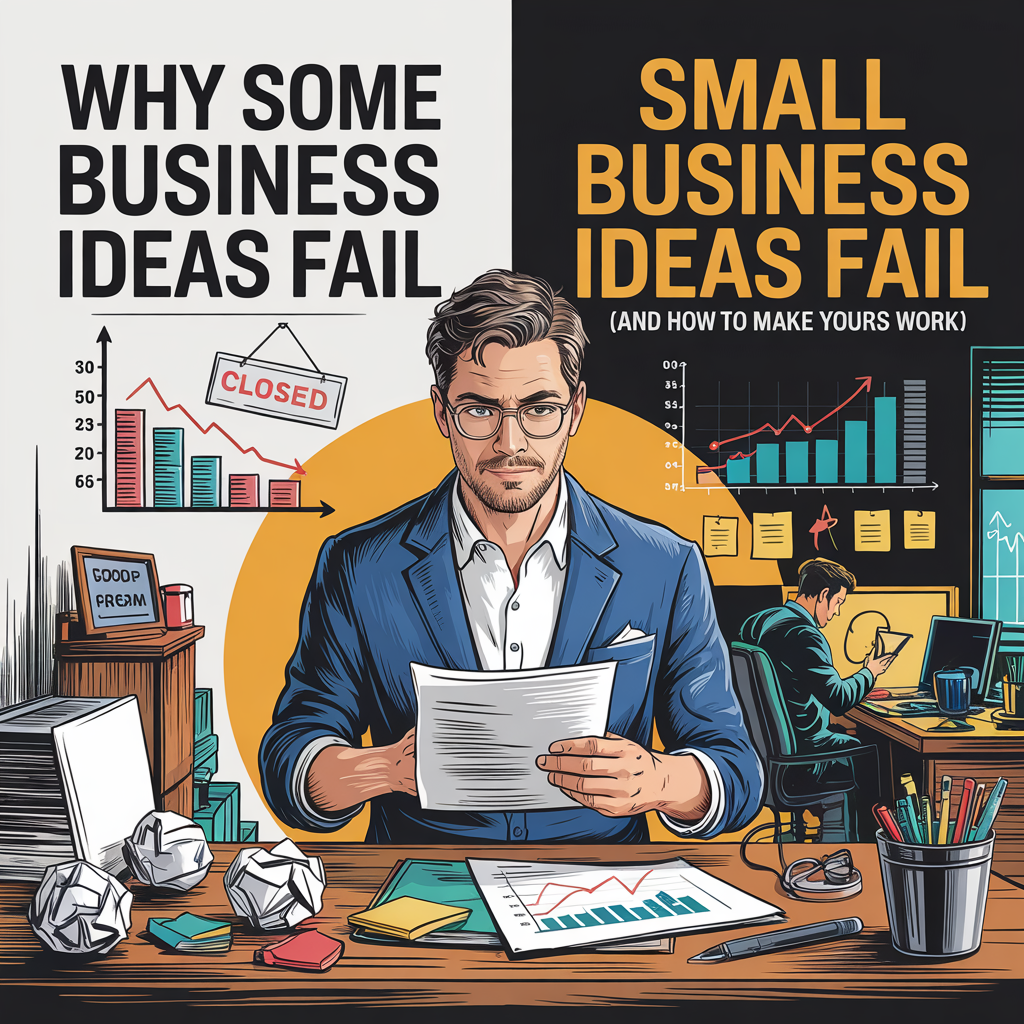Why Some Small Business Ideas Fail (And How to Make Yours Work)
Small Business Idea Validation is often the missing step that separates successful ventures from those that quickly fizzle out and disappear.
When entrepreneurs rush to market without testing their assumptions, they’re essentially gambling with their time and resources.
The path to small business success isn’t simply about having a brilliant concept—it requires methodical verification that your solution addresses a genuine market need.
Statistics reveal a sobering reality: approximately 20% of small businesses fail within their first year, and nearly half don’t survive past five years.
Behind these numbers are real people who invested their dreams, savings, and countless hours into ventures that ultimately couldn’t sustain themselves.
While failure provides valuable lessons, wouldn’t you rather learn these lessons before investing everything into your business?
This article examines why promising small businesses collapse and provides actionable strategies to ensure your concept doesn’t become another statistic.
By understanding the critical role of Small Business Idea Validation and implementing proven testing methodologies, you’ll dramatically improve your chances of building something that truly resonates with customers and stands the test of time.
We strongly recommend that you check out our guide on how to take advantage of AI in today’s passive income economy.
Table of Contents
The Hidden Traps: Why Promising Ideas Hit Dead Ends
Many entrepreneurs begin their journey with unbridled optimism, convinced their idea will revolutionize the market, only to face harsh realities months later.
Small Business Idea Validation should be your first line of defense against pouring resources into a concept that lacks sustainable market appeal.
When founders skip thorough validation, they risk building products or services that nobody actually wants or needs badly enough to pay for.
The entrepreneurial graveyard is filled with businesses that seemed brilliant on paper but failed to connect with real customer problems.
Consider the case of Juicero, a startup that raised over $120 million to create a $400 juicer that simply squeezed pre-packaged juice bags—something consumers quickly realized they could do with their hands.
This cautionary tale highlights what happens when companies develop solutions without validating that consumers actually have the problem they’re trying to solve.
Had Juicero invested more time in Small Business Idea Validation, they might have discovered that their target market didn’t need such an expensive, complex solution.
The good news is that with proper testing and validation techniques, you can avoid similar pitfalls and refine your concept before committing significant resources.
Misreading the Market: The Fatal Assumption
One of the most common reasons small businesses fail is founders making assumptions about what customers want instead of gathering concrete evidence.
Small Business Idea Validation provides the framework to test these assumptions systematically before you’ve invested too deeply.
Many entrepreneurs fall in love with their solution rather than focusing on the underlying problem they’re attempting to solve.
This solution-first mindset leads to creating products or services that don’t address genuine pain points that customers are willing to pay to resolve.
Market research isn’t just about confirming that people like your idea—it’s about verifying they’ll actually open their wallets for it.
The validation process helps you understand not just whether people need your solution, but how badly they need it and what they’re currently doing to address that need.
Effective Small Business Idea Validation includes speaking directly with potential customers, analyzing competing solutions, and testing minimal versions of your product to gauge interest.
By gathering this critical information early, you can pivot your approach before spending months or years heading in the wrong direction.
Resource Misallocation: Building Too Much, Too Soon
Entrepreneurs often pour excessive resources into perfecting their product before confirming market interest, a costly approach that Small Business Idea Validation helps prevent.
Building elaborate websites, manufacturing inventory, or developing feature-rich apps before validating core assumptions can quickly deplete your startup capital.
The wiser approach is to create a minimum viable product (MVP) that tests your fundamental value proposition with minimal investment.
This lean methodology allows you to gather real-world feedback while conserving resources for later stages when your direction is more certain.
Consider how Dropbox validated their idea—instead of building their entire cloud storage platform immediately, they created a simple video demonstration of how the service would work.
This video generated thousands of signups from interested users, validating demand before the founders wrote a single line of code for the actual product.
Small Business Idea Validation emphasizes this “measure twice, cut once” philosophy that can save entrepreneurs from wasteful development cycles.
By focusing first on confirming demand, you ensure that when you do invest in building your solution, you’re solving a problem people genuinely care about.
The Validation Blueprint: Making Your Small Business Work
Successful entrepreneurs understand that Small Business Idea Validation isn’t just a preliminary step—it’s an ongoing process throughout the business lifecycle.
Implementing a structured validation approach helps filter out ideas that won’t gain traction while strengthening those with genuine potential.
The most effective validation frameworks combine quantitative data with qualitative insights to form a comprehensive picture of market opportunity.
This balanced approach helps you understand not just the size of your potential market but also the specific needs, preferences, and behaviors of your target customers.
Small Business Idea Validation begins with clearly articulating your core business hypothesis—the specific problem you’re solving and for whom.
Once this foundation is established, you can methodically test each assumption underlying your business model before committing significant resources.
Remember that validation isn’t about seeking confirmation bias—it’s about honestly evaluating whether your idea addresses a genuine market need.
This sometimes means embracing uncomfortable truths and being willing to pivot or even abandon ideas that the evidence suggests won’t succeed.
Customer Discovery: The Heart of Validation
At the center of effective Small Business Idea Validation is direct engagement with potential customers through structured conversations and observations.
These interactions aim to uncover not just what customers say they want, but what they actually do when confronted with the problem you’re trying to solve.
Begin by identifying who you believe your target customers are and reaching out to have meaningful conversations about their challenges and current solutions.
The goal isn’t to pitch your idea but to listen deeply to understand their world and whether the problem you’ve identified is genuinely significant to them.
Small Business Idea Validation requires asking open-ended questions that don’t lead the respondent toward your desired answer.
Questions like “What’s the most frustrating part of your current process?” yield more valuable insights than “Would you use a product that does X?”
Document patterns that emerge across multiple customer conversations, particularly around pain points that are mentioned frequently and with emotional intensity.
These recurring themes often indicate promising problem spaces where new solutions could gain significant traction if properly executed.
Prototype Testing: Validate Before You Build
Creating simple prototypes allows potential customers to interact with your concept, providing invaluable feedback for Small Business Idea Validation.
These early representations don’t need to be fully functional—paper sketches, digital mockups, or simple landing pages can effectively communicate your core value proposition.
The key is designing experiments that measure meaningful engagement rather than mere interest or positive feedback.
For example, a “coming soon” page that asks visitors to join a waitlist or pre-order provides stronger validation than one that simply collects email addresses.
Small Business Idea Validation through prototyping helps identify which features are truly essential versus those that could be developed later.
This prioritization ensures you focus your limited initial resources on the elements that deliver the most value to customers.
Remember that the goal of prototype testing isn’t to perfect your product but to learn quickly through each iteration.
Each round of feedback brings you closer to a solution that genuinely resonates with your target market’s needs and expectations.
Competitive Analysis: Finding Your Edge
Understanding the competitive landscape is a crucial component of Small Business Idea Validation that too many entrepreneurs overlook or perform superficially.
Begin by identifying both direct competitors (businesses solving the same problem) and indirect competitors (alternative ways customers address the problem).
For each competitor, analyze their strengths, weaknesses, pricing strategy, and customer feedback to identify gaps your business might fill.
Look beyond obvious competitors to consider future threats from adjacent industries or technological developments that might disrupt your market.
Small Business Idea Validation requires honest assessment of whether your solution offers meaningful differentiation from existing alternatives.
If your only advantage is being “cheaper” or “better quality,” you may need to reconsider your approach or find more specific ways to distinguish your offering.
Pay particular attention to competitors who have failed in your space—understanding why they couldn’t succeed provides valuable cautionary lessons.
Similarly, study successful competitors to identify which elements of their business model and value proposition you might adapt or improve upon.
From Validation to Execution: Crossing the Critical Bridge
Once your Small Business Idea Validation confirms market potential, the next challenge is translating that validation into effective execution.
Many entrepreneurs struggle with this transition, either rushing ahead too quickly or becoming paralyzed by the prospect of scaling their validated concept.
Successful execution requires developing systems and processes that can consistently deliver your core value proposition to customers.
This means building not just your product or service but the operational infrastructure to support sustainable growth.
Small Business Idea Validation continues even as you move into execution, with regular check-ins to ensure you’re staying aligned with market needs.
As you gain customers, their feedback becomes an invaluable source of ongoing validation and refinement for your business model.
Remember that execution isn’t a linear process—it involves continuous experimentation, learning, and adaptation based on real-world results.
The most successful small businesses maintain the experimental mindset of validation even as they grow, constantly testing new approaches to better serve their market.
Financial Reality: Ensuring Sustainable Economics
No amount of Small Business Idea Validation matters if your business model can’t generate sustainable profits over time.
During validation, you should test not just whether customers want your solution but whether they’ll pay enough to create viable unit economics.
Calculate your customer acquisition costs (CAC) and compare them against your customer lifetime value (CLV) to ensure you can profitably acquire customers.
A common mistake is underestimating costs or overestimating revenue, leading to businesses that can’t sustain themselves despite having customers.
Small Business Idea Validation should include developing financial projections based on realistic assumptions tested during your market research.
These projections help identify potential cash flow challenges before they become critical and guide decisions about pricing, marketing strategy, and operational investments.
Remember that sustainable businesses typically require margins that support not just covering costs but reinvesting in growth and innovation.
If your validation indicates that customers aren’t willing to pay prices that support these margins, you may need to reconsider your business model or target market.
Building a Minimum Viable Audience
Before launching your business, Small Business Idea Validation should include building relationships with potential customers who can provide initial traction.
This “minimum viable audience” serves as both your first customer base and a source of early feedback and referrals.
Engaging this audience throughout your validation process creates advocates who feel invested in your success because they’ve contributed to shaping your solution.
These early adopters often become valuable evangelists who help spread awareness of your business through word-of-mouth.
Small Business Idea Validation includes identifying where your target customers gather, both online and offline, and establishing a presence in these communities.
By providing value through content, expertise, or community contributions before asking for sales, you build credibility and relationships that support your launch.
Consider pre-selling your product or service to this audience as a final validation step before full-scale launch.
Customers willing to put down deposits or pre-payments provide the strongest possible validation that your offering addresses a genuine need they’re willing to pay to solve.
Navigating the Emotional Journey of Entrepreneurship
The process of Small Business Idea Validation often takes entrepreneurs on an emotional rollercoaster as they confront both encouraging and discouraging feedback.
Maintaining objectivity during this journey is crucial—you must separate your identity and ego from the business idea you’re testing.
Remember that validation isn’t about proving you’re right; it’s about discovering the truth about market needs before investing significant resources.
When feedback suggests your initial concept isn’t viable, view this as valuable information that saved you from a costly mistake rather than a personal failure.
Small Business Idea Validation requires intellectual honesty and the courage to face reality even when it contradicts your hopes or assumptions.
This mindset distinguishes successful entrepreneurs who adapt based on evidence from those who persist with flawed ideas due to emotional attachment.
Surround yourself with mentors and advisors who can provide objective perspectives when you’re too close to your idea to see its flaws clearly.
These trusted voices help you interpret validation data accurately and make difficult decisions about pivoting or persisting with greater confidence.
The Pivot: When and How to Change Direction
Small Business Idea Validation sometimes reveals that while your core problem is real, your solution needs significant adjustment to gain traction.
Recognizing when to pivot is one of the most valuable skills entrepreneurs can develop through the validation process.
A pivot doesn’t necessarily mean abandoning your vision entirely—often, it means refining your approach based on market feedback.
For example, you might target a different customer segment, adjust your pricing model, or emphasize different features than you initially planned.
Small Business Idea Validation provides the data you need to make informed pivot decisions rather than changing direction based on hunches or panic.
The best pivots maintain what’s working while changing what isn’t, preserving the accumulated learning and assets from your previous approach.
Communicate transparently with early supporters about why you’re pivoting and how the new direction better addresses their needs.
This transparency maintains trust and often brings your early advocates along with you as you refine your business model.
Conclusion: Validation as Your Competitive Advantage
In today’s competitive business landscape, thorough Small Business Idea Validation isn’t just helpful—it’s a critical competitive advantage.
Entrepreneurs who rigorously test their assumptions before scaling their businesses dramatically increase their odds of long-term success.
The validation process helps you develop deep customer insights that inform not just your initial launch but your entire business strategy.
These insights become increasingly valuable as you grow, helping you stay connected to evolving customer needs and market trends.
Small Business Idea Validation transforms entrepreneurship from a high-risk gamble into a systematic discovery process with manageable risks.
While it can’t guarantee success, it significantly improves your chances by ensuring you’re building something people genuinely want and will pay for.
Remember that validation isn’t a one-time event but an ongoing mindset of testing, learning, and refining throughout your business journey.
By embracing this approach, you position your small business to not just survive but thrive in an ever-changing marketplace where customer needs and competitive pressures constantly evolve.

We strongly recommend that you check out our guide on how to take advantage of AI in today’s passive income economy.




